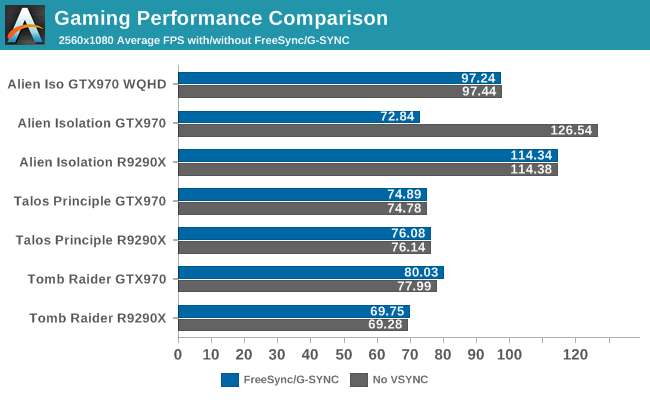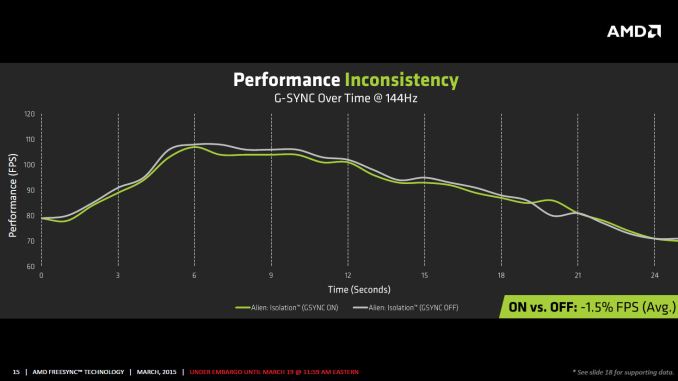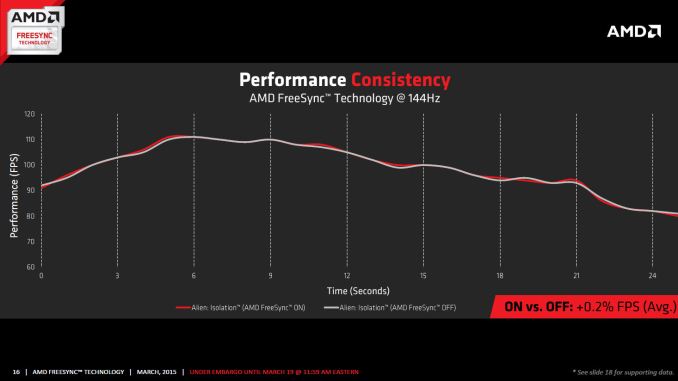The AMD FreeSync Review
by Jarred Walton on March 19, 2015 12:00 PM ESTFreeSync vs. G-SYNC Performance
One item that piqued our interest during AMD’s presentation was a claim that there’s a performance hit with G-SYNC but none with FreeSync. NVIDIA has said as much in the past, though they also noted at the time that they were "working on eliminating the polling entirely" so things may have changed, but even so the difference was generally quite small – less than 3%, or basically not something you would notice without capturing frame rates. AMD did some testing however and presented the following two slides:
It’s probably safe to say that AMD is splitting hairs when they show a 1.5% performance drop in one specific scenario compared to a 0.2% performance gain, but we wanted to see if we could corroborate their findings. Having tested plenty of games, we already know that most games – even those with built-in benchmarks that tend to be very consistent – will have minor differences between benchmark runs. So we picked three games with deterministic benchmarks and ran with and without G-SYNC/FreeSync three times. The games we selected are Alien Isolation, The Talos Principle, and Tomb Raider. Here are the average and minimum frame rates from three runs:


Except for a glitch with testing Alien Isolation using a custom resolution, our results basically don’t show much of a difference between enabling/disabling G-SYNC/FreeSync – and that’s what we want to see. While NVIDIA showed a performance drop with Alien Isolation using G-SYNC, we weren’t able to reproduce that in our testing; in fact, we even showed a measurable 2.5% performance increase with G-SYNC and Tomb Raider. But again let’s be clear: 2.5% is not something you’ll notice in practice. FreeSync meanwhile shows results that are well within the margin of error.
What about that custom resolution problem on G-SYNC? We used the ASUS ROG Swift with the GTX 970, and we thought it might be useful to run the same resolution as the LG 34UM67 (2560x1080). Unfortunately, that didn’t work so well with Alien Isolation – the frame rates plummeted with G-SYNC enabled for some reason. Tomb Raider had a similar issue at first, but when we created additional custom resolutions with multiple refresh rates (60/85/100/120/144 Hz) the problem went away; we couldn't ever get Alien Isolation to run well with G-SYNC using our custome resolution, however. We’ve notified NVIDIA of the glitch, but note that when we tested Alien Isolation at the native WQHD setting the performance was virtually identical so this only seems to affect performance with custom resolutions and it is also game specific.
For those interested in a more detailed graph of the frame rates of the three runs (six total per game and setting, three with and three without G-SYNC/FreeSync), we’ve created a gallery of the frame rates over time. There’s so much overlap that mostly the top line is visible, but that just proves the point: there’s little difference other than the usual minor variations between benchmark runs. And in one of the games, Tomb Raider, even using the same settings shows a fair amount of variation between runs, though the average FPS is pretty consistent.


















350 Comments
View All Comments
lordken - Thursday, March 19, 2015 - link
are you sure? they only have to come with different name (if they want). Just as both amd/nvidia calls and use "DisplayPort" as DisplayPort , they didnt have came up with their own implementations of it as DP is standardized by VESA so they used that.Or I am missing your point what you wanted to say.
Question is if it become core/regular part of lets say DP1.4 onwards as just now it is only optional aka 1.2a and not even in DP1.3 - if I understand that correctly.
iniudan - Thursday, March 19, 2015 - link
Well the implementation need to be in their driver, they not gonna give that to Nvidia. =pchizow - Thursday, March 19, 2015 - link
So it is also closed/proprietary on an open spec? Gotcha, so I guess Nvidia should just keep supporting their own proprietary solution. Makes sense to me.ddarko - Thursday, March 19, 2015 - link
You know repeating a falsehood 100 times doesn't make it true, right?chizow - Tuesday, March 24, 2015 - link
You mean like repeating FreeSync can be made backward compatible with existing monitors with just a firmware flash, essentially for Free? I can't remember how many times that nonsense was tossed about in the 15 months it took before FreeSync monitors finally materialized.Btw, it is looking more and more like FreeSync is a proprietary implementation based on an open-spec just as I stated. FreeSync has recently been trademarked by AMD so there's not even a guarantee AMD would allow Nvidia to enable their own version of Adaptive-Sync on FreeSync (TM) branded monitors.
ddarko - Thursday, March 19, 2015 - link
From the PC Perspective article you've been parroting around like gospel all day today:"That leads us to AMD’s claims that FreeSync doesn’t require proprietary hardware, and clearly that is a fair and accurate benefit of FreeSync today. Displays that support FreeSync can use one of a number of certified scalars that support the DisplayPort AdaptiveSync standard. The VESA DP 1.2a+ AdaptiveSync feature is indeed an open standard, available to anyone that works with VESA while G-Sync is only offered to those monitor vendors that choose to work with NVIDIA and purchase the G-Sync modules mentioned above."
http://www.pcper.com/reviews/Displays/AMD-FreeSync...
That's the difference between an open and closed standard, as you well know but are trying to obscure with FUD.
chizow - Friday, March 20, 2015 - link
@ddarko, it says a lot that you quote the article but omit the actually relevant portion:"Let’s address the licensing fee first. I have it from people that I definitely trust that NVIDIA is not charging a licensing fee to monitor vendors that integrate G-Sync technology into monitors. What they do charge is a price for the G-Sync module, a piece of hardware that replaces the scalar that would normally be present in a modern PC display. It might be a matter of semantics to some, but a licensing fee is not being charged, as instead the vendor is paying a fee in the range of $40-60 for the module that handles the G-Sync logic."
And more on that G-Sync module AMD claims isn't necessary (but we in turn have found out a lot of what AMD said about G-Sync turned out to be BS even in relation to their own FreeSync solution):
"But in a situation where the refresh rate can literally be ANY rate, as we get with VRR displays, the LCD will very often be in these non-tuned refresh rates. NVIDIA claims its G-Sync module is tuned for each display to prevent ghosting by change the amount of voltage going to pixels at different refresh rates, allowing pixels to untwist and retwist at different rates."
In summary, AMD's own proprietary spec just isn't as good as Nvidia's.
Crunchy005 - Friday, March 20, 2015 - link
AMDs spec is not proprietary so stop lying. Also I love how you just quoted in context what you quoted out of context in an earlier comment. The only argument you have against freeSync is ghosting and as many people have pointed out is that it is not an inherent issue with free sync but the monitors themselves. The example given in that shows three different displays that all are affected differently. The LG and benq both show ghosting differently but use the same freeSync standard so something else is different here and not freeSync. On top of that the LG is $100 less than the asus and the benQ $150 less for the same features and more inputs. I don't see how a better more well rounded monitor that can offer variable refresh rates with more features that is cheaper is a bad thing. From the consumer side of things that is great! A few ghosting issues that i'm sure are hardly noticeable to the average user is not a major issue. The videos shown there are taken at a high frame rate and slowed down, then put into a compressed format and thrown on youtube in what is a very jerky hard to see video, great example for your only argument. If the tech industry could actually move away from proprietary/patented technology, and maybe try to actually offer better products and not "good enough" products that force customers into choosing and being locked into one thing we could be a lot father along.chizow - Friday, March 20, 2015 - link
Huh? How do you know Nvidia can use FreeSync? I am pretty sure AMD has said Nvidia can't use FreeSync, if they decide to use something with DP 1.2a Adaptive Sync they have to call it something else and create their own implementation, so clearly it is not an Open Standard as some claim.And how is it not an issue inherent with FreeSync? Simple test that any site like AT that actually wants answers can do:
1) Run these monitors with Vsync On.
2) Run these monitors with Vsync Off.
3) Run these monitors with FreeSync On.
Post results. If these panels only exhibit ghosting in 3), then obviously it is an issue caused by FreeSync. Especially when we have these same panel makers (the 27" 1440p BenQ is apparently the same AU optronics panel as the ROG Swift) have panels on the market, both non-FreeSync and G-Sync) that have no such ghosting.
And again you mention the BenQ vs. the Asus, well guess what? Same panel, VERY different results. Maybe its that G-Sync module doing its magic, and that it actually justifies its price. Maybe that G-Sync module isn't bogus as AMD claimed and it is actually the Titan X of monitor scalers and is worth every penny it costs over AMD FreeSync if it is successful at preventing the kind of ghosting we see on AMD panels, while allowing VRR to go as low as 1FPS.
Just a thought!
Crunchy005 - Monday, March 23, 2015 - link
Same panel different scalers. AMD just uses the standard built into the display port, the scaler handles the rest there so it isn't necessarily freeSync but the variable refresh rate technology in scaler that would be causing the ghosting. So again not AMD but the manufacturer."If these panels only exhibit ghosting in 3), then obviously it is an issue caused by FreeSync"
Haven't seen this and you haven't shown us either.
"Maybe its that G-Sync module doing its magic"
This is the scaler so the scaler, not made by AMD, that supports the VRR standard that AMD uses is what is controlling that panel not freeSync itself. Hence an issue outside of AMDs control. Stop lying and saying it is an issue with AMD. Nvidia fanboys lying, gotta keep them on the straight and narrow.